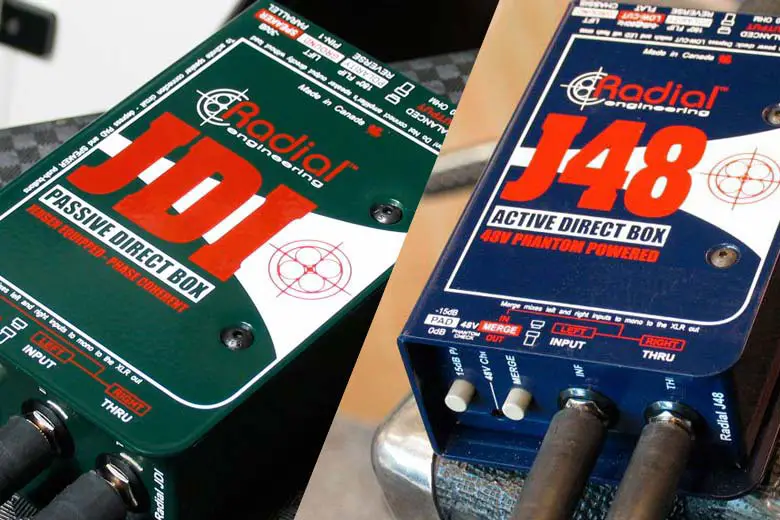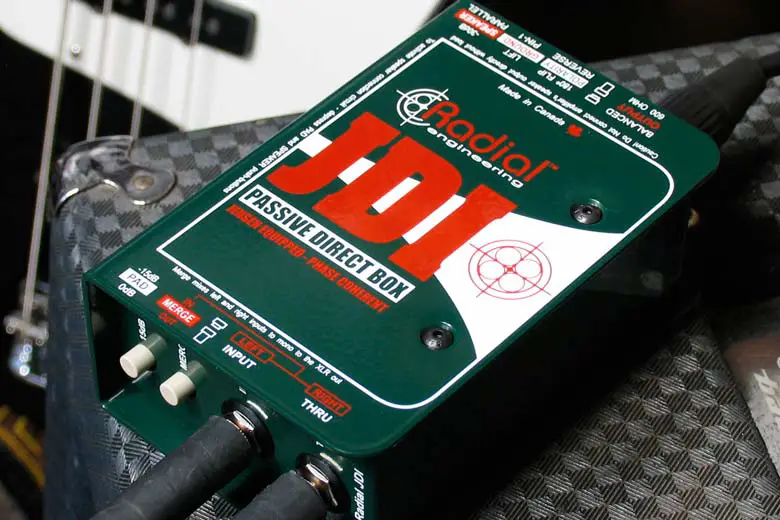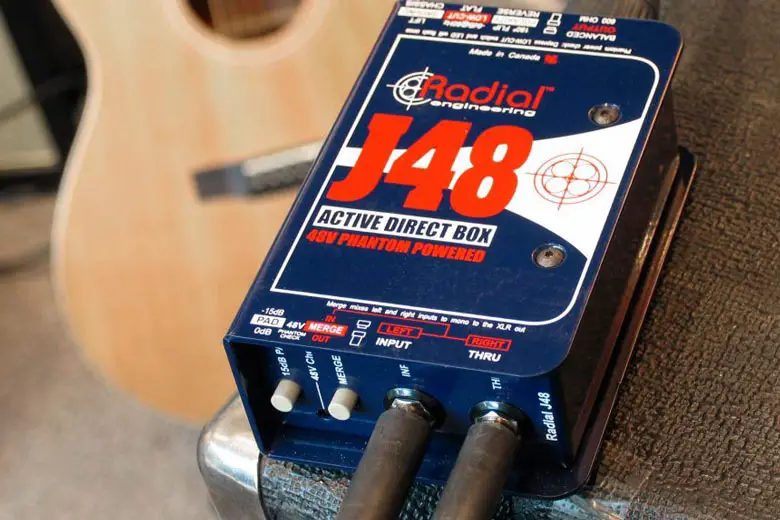Direct input units, often called DI boxes, are an amazing piece of equipment that lets us reap all the benefits of XLR connectors. The signal is balanced and shielded from static noise. However, choosing between an active and a passive DI box can be puzzling.
The kind of DI box that’s right for you depends on your instrument. Use a passive DI box for active sources such as keyboards, guitars with active pickups, and electronic drums. Use active DI boxes for passive sources like guitars and basses with passive pickups.
Admittedly, the answer to what kind of DI box you need isn’t cut and dry. I’ll go into great detail about active and passive DI boxes in this article. More importantly, I’ll tell you the pros and cons of each so that you can make an educated choice.

Do You Need an Active or Passive DI Box?
You need an active DI box for instruments that don’t have an active power source. Most basses and electric guitars require active DI boxes. You need a passive DI box if your instrument has an active power source from a battery or power cord. Most keyboards use passive DI boxes.
What I just described is a very good rule of thumb. You can follow it and expect great results.
However, there are situations where active and passive boxes are interchangeable.
Use a passive DI box with a guitar that has passive pickups?
In fact, you could use a passive DI box with a guitar that has passive pickups.
The only problem is that this high-impedance instrument won’t have a lot of power. The voltage will drop, and the tone will change considerably.
Most notably, you lose some of that all-important treble.
Furthermore, the signal range will be severely limited.
You can’t use a 100 ft (30.48 m) cable with two passive components and expect it to sound good.
That’s because passive DI boxes need the power from an active instrument to push the signal.
But what if you use an active DI box with a guitar that has active pickups?
This is a much more viable scenario. Your signal will be amplified twice before it gets to your sound system. And you usually won’t have problems with this setup.
However, the signal becomes too powerful if you turn the volume knob on your guitar up and the gain on the DI box. This, in turn, causes clipping.
Clipping is when the soundwave gets cut on top, which causes high-frequency loss.
You can remedy this by turning the volume down on both the DI box and your instrument.
If your guitar has an active/passive pickup, switch it into the passive mode or take the batteries out.
Note that recording even with the wrong DI box for your instrument is still miles ahead of recording it with a microphone.
When it comes to acoustic guitars, piezoelectric pickups deserve a special mention. They pick up both the vibrations from your strings and the guitar body.
You still need an active DI box for piezo pickups. But it’s best to use a DI box made specifically for them because of their unique nature.

Radial Engineering PZ-DI Acoustic Direct Box, available on Amazon.com, can simulate a tube amp sound, it’s phantom-powered, and there’s a low-cut filter.
What’s the Difference Between an Active and a Passive Source?
An active source is powered using a power cord or batteries. There’s a small amplifier in the instrument that boosts the signal to make it louder and clearer. A passive source doesn’t have any external power. Most electric instruments are considered passive sources.
The example I always use to explain the difference is guitars with active pickups.
If there’s a battery and you turn the knob to active, you have an active source. Turn the knob to passive or take the batteries out – it becomes a passive source.
You can’t convert a passive source into an active one. That’s why active DI boxes exist.
But you can use most active instruments with both active and passive DI boxes. It’ll work even if you keep your instrument in active mode, but it’s best to use it in passive mode if you can.
Pros and Cons of Passive DI Boxes
Passive DI boxes are very simple devices. They convert your high impedance output into a low impedance one using the bare minimum of components needed.

They have a few upsides and drawbacks that you should be aware of before buying one.
Pros of Passive DI Boxes
Let’s first talk about the advantages that passive DI boxes have compared to active boxes.
Passive DI Boxes Don’t Need External Power
By far, the biggest benefit of passive DI boxes is that they just work.
Imagine using an active DI box, concert after concert, and the battery dies on stage. That would be a lot of embarrassment and frustration.
And you wouldn’t even think of the battery being low on juice when that happens. You’d troubleshoot everything else.
This can’t happen with a passive DI box.
It uses the power from your instrument to push the signal through the cable. It doesn’t matter how long your cord is. It’ll always work.
You never have to worry about phantom powering the box, compatibility with mixers, and carrying batteries in your gig bag.
Passive DI Boxes Don’t Add Amplification Hum
As Marshall explains it, amps always make some noise when they’re idle. This fact extends to the amp in active DI boxes too.
But passive DI boxes are very simple.
All they contain is a transformer and a few resistors. These add any noise. Conversely, they remove existing static noise.
Passive DI Boxes Are Fantastic at Isolating Your Signal
The main function of a DI box is to isolate the signal coming from your instrument. The signal must stay untouched even with 200 ft (60.96 m) cables.
And passive DI boxes do exactly that. A passive DI box converts your signal into XLR without adding noise in and of itself.
It does this much better than an active box because it has super simple circuitry.
Passive DI Boxes Are Extremely Durable and Reliable
As I explained earlier, DI boxes are just a transformer and maybe a few resistors.
There aren’t any capacitors or other less durable components that could blow in a few years.
You can trust your passive DI box that it’ll always work, no matter what. As a matter of fact, it probably works even if it’s from the 1960s.
It’ll never fail you in the middle of an important gig.
Passive DI Boxes Work Great With Powered Instruments
The only drawback of passive DI boxes is that they don’t have any power to push the signal.
Enter your electrically powered instrument.
I’m personally a huge fan of using my bass guitar with active pickups and a passive DI box.
I get all the power that I want directly from the bass. Plus, I can adjust the volume on the instrument itself.
If you use a keyboard, you’ll be happy to know that your passive DI box isn’t interfering with your sound or clarity.
And that’s the good thing about passive DI boxes. They just work.
Cons of Passive DI Boxes
Of course, passive DI boxes come with some drawbacks. If they were perfect, active boxes wouldn’t exist. Let’s take a look.
You Need Power From the Instrument To Push the Signal
The biggest drawback by far is that you can’t use passive DI boxes with all instruments.
They’ll only work with instruments that are already powered. This pretty much limits you to a handful of instruments and active pickups on guitars.
This just shifts your responsibility of changing batteries from an active box to your guitar. So, nothing lost, nothing gained.
The Quality of Your Sound Depends on the Transformer
The transformer is the single most important component in a passive DI box. Some active DI boxes have it too, but it’s less important.
A poor transformer can ruin the sound of your beautiful instrument.
The quality of the transformer drives the price up, but at least you get better sound.
You Can’t Use Passive DI Boxes With Many Instruments
Only a handful of instruments are powered. Passive DI boxes are great for keyboards and guitars with active pickups, but not much else.
If you only have one instrument, that’s not an issue. But if you’re a multi-talented musician, this can be somewhat limiting.
Passive DI Boxes May Change the Tone Slightly
I said many good things about passive DI boxes and sound quality earlier, and they’re true.
However, there’s always a slight tone change associated with passive DI boxes because they take away a bit of the electric current.
Of course, low-quality DI boxes will have a much bigger impact on your tone than something good.
Pros and Cons of Active DI Boxes
You now know everything about passive DI boxes.
It’s time to shift our focus to active ones to see what they have to offer.

Pros of Active DI Boxes
Active DI boxes aren’t that different from passive boxes. They just add an added amplifier that boosts the signal of passive sources.
Nonetheless, that alone is enough to change everything.
Active DI Boxes Work With Any Instrument
Passive DI boxes only work with powered instruments, which is extremely limiting.
Thankfully, active DI boxes exist. They work with any instrument, powered or otherwise.
Their main use is for passive electronic instruments like electric guitars, basses, and electric wind instruments.
The weak signal from your high-impedance instrument becomes powerful enough to travel hundreds of feet without any signal loss.
Active DI Boxes Are Often Loaded With Useful Features
There are always a few features that are baked directly into an active DI box. There’s stuff like ground lift, which lets you separate the two ground paths.
You can use isolated line output and pad to reduce or even eliminate noise.
There are a few more common features that you might need from time to time, like throughput. It allows you to split the signal between the amp and the sound system.
You Get More of an Amp-Like Sound With Active DI Boxes
Since there’s a small preamp inside an active DI box, there’s no wonder that this effect happens.
Guitars, especially bass guitars, often don’t sound exactly like you expect them to on stage. An active box can somewhat remedy this because it boosts the signal before it gets into the mixer.
Just don’t expect wonders from a direct box because you may still want to use a clean boost pedal or preamp.
The Signal From an Active DI Box Can Travel Long Distances
Passive DI boxes depend on the instrument’s power to push the signal through the whole cable length. This isn’t much of an issue unless the cable is very long or there isn’t enough power.
Active DI boxes can push the signal much further, thanks to the built-in amp.
Powerful boxes can easily add several hundred feet to the maximum cable length.
Cons of Active DI Boxes
Active boxes have a few caveats that you should be aware of before you buy them. Let’s see what they are.
Active DI Boxes Require Power to Run
The biggest inconvenience with active boxes is that they need to be powered. You must carry a spare battery wherever you go.
You should probably replace it before every other gig, just to stay safe.
If your active box supports phantom power, it becomes less of an issue.
However, some mixers don’t have built-in power supplies for your box. That’s why you should have a spare battery with you at all times.
Active DI Boxes Don’t Have Galvanic Isolation
If you have a floating output in your active DI box, you don’t have galvanic isolation. No galvanic isolation means that there’s no direct wire going from your input to the output.
Instead, the signal is transferred with electromagnets.
The lack of galvanic isolation means that the box is prone to interference, translating into noise.
Active DI Boxes Can Die Early
I explained earlier how durable passive DI boxes are. They don’t have any complicated circuitry that might randomly break.
Active boxes do. That makes them slightly less durable. If only one component of many fails, you can throw the whole thing out.
The Amp From the DI Box Can Add Some Buzz or Hum
Another issue with the preamp feature of active DI boxes is the noise it adds. Pretty much every amp produces some sort of static noise.
You usually don’t hear it when you play because it’s not very loud, but it’s always there. That’s why amps come with an on/off switch.
Unfortunately, that’s the price you have to pay if you want to use an active box.
There’s a Minor Tone Change With High Impedance Instruments
High impedance instruments cause very little voltage draw. But that’s enough to cause tone change with these delicate instruments.
That’s why some active DI boxes have built-in tone control knobs. You can use it to fix the tone to some extent.
Unfortunately, it’ll never sound like the source.
Active vs. Passive DI Box With Active Pickups
By now, you probably know what DI box you’re going to pick.
However, there’s one thing I didn’t clear up – which DI box you should get with active pickups.
The truth is that there’s no easy answer. I prefer passive DI boxes with active pickups because they usually sound better.
Also, it requires less forethought when it comes to batteries. There’s always juice in my pickup batteries because I play it all the time.
But not everybody wants to waste their energy on having to think about batteries constantly.
In that case, an active DI box that supports phantom power is for you.
Remember to switch to passive pickup mode when using an active direct box.
Final Thoughts
Both active and passive DI boxes have their place on the market.
Active DI boxes are great for passive instruments like most guitars and basses. The box adds enough power to send the signal through very long cables.
Passive DI boxes are less complex, meaning they’re more durable and don’t affect your sound as much. However, you can only use it if you have active pickups or an active power source.
